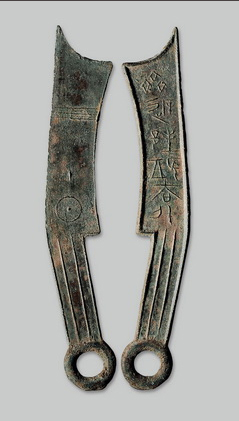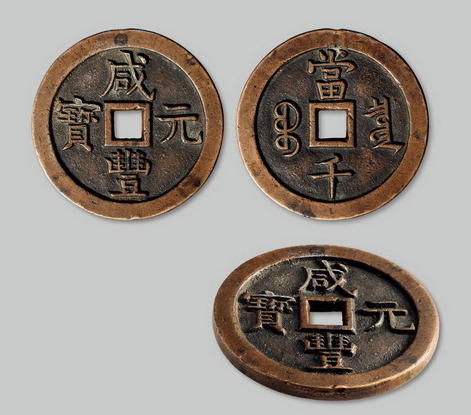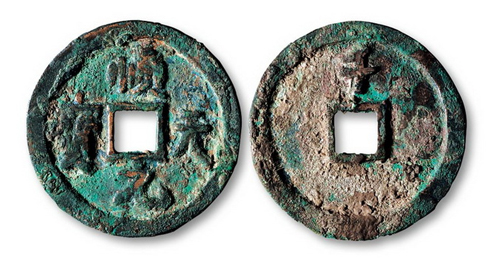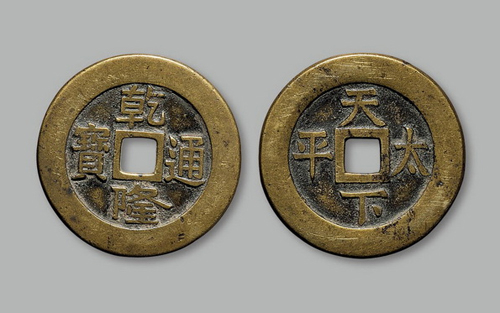- Lot
- Information
Ancient coins bear loyal witness to the vicissitudes of history and civilization.
China was the first nation on earth to adopt a common currency. For around 4,000 years, the country has produced coins from an array of materials in various shapes and sizes, beginning with shells in the Shang Dynasty (17th - 11th centuries BC). Metal coins first appeared in the Spring and Autumn Period (770-476 BC), and became popular during the Warring States Period (475-221 BC). Technology progressed in the Qin Dynasty (221-206 BC), with the circulation of round bronze coins with square holes at their center. It was at the end of the Qing Dynasty (1644-1911) that machine-pressed coins debuted. All have contributed to the grand Chinese legacy of minted currency.

Six-Character Knife Coin, with the Chinese character for sun on the reverse.
Coin collecting has long been a hobby in China. For decades ancient coins could be picked up quite cheaply on the mainland, but their prices have skyrocketed over the past years. These days, some of the rarest examples can fetch several million yuan at auction.
The value of ancient coins is generally determined by the coin’s historical context and age, and by its rarity. For example, the Western Han Dynasty (206 BC—AD 24) cast about 28 billion Wuzhu coins, and this enormous amount brought down their worth. Today, run-of-the-mill varieties sell for only a few yuan each. Coins from some short-lived dynasties or those cast during peasant uprisings have become valuable treasures in collectors’ markets due to limited amounts and short circulation periods.
Until perhaps one or two decades ago, it was uncommon for rare coins to go for more than a few thousand yuan at auction in China. But as domestic collectors’ markets have burgeoned, people are looking to ancient money as a way of, well, making money.

Xianfeng Yuanbao of the Qing Dynasty sold for RMB 747,500.
At a 2011 auction conducted by China Guardian Auctions Co., Ltd, three ancient coins fetched over RMB one million each. Several others sold for thousands or tens of thousands of yuan.
At the top of the list was the Xiwang Shanggong gold coin, which sold for RMB 2.3 million at the auction. It is small – 50.4 mm in diameter and weighs 48.6 grams – but in perfect condition. The coin, whose name translates literally as “Award from the King of the Great West to outstanding generals and soldiers,” was commissioned by Zhang Xianzhong, leader of a peasant uprising in the late Ming Dynasty (1368 – 1644) who proclaimed himself “King of the Great West,” but ruled for only three years before being killed by Qing forces. The coins he adopted were made of gold, silver and copper, gold ones being the most valuable and rarest.
In second place at the auction was the Qi Duke Returning to the Capital Six-Character Knife Coin, sold for RMB 1.495 million. It is 185 mm in length and boasts a beautiful inscription of the Chinese Character Ri (meaning sun) on its obverse. This coin, cast in the shape of a knife, was commissioned by Duke Xiang, who ruled the State of Qi from 283 to 265 BC. Xiang was enthroned at a time when the state had lost all its territory but two cities. After years of bitter battles under Xiang’s steady leadership, Qi retrieved all its lands including its capital city. In celebration of the victory, Qi minted a set of coins, which became the earliest commemorative coins in Chinese history. They are generally named according to the number of Chinese characters inscribed on their front surface – in threes, fours, fives and sixes, those with six characters being the most valuable.

Shuntian Yuanbao of the Tang Dynasty sold for RMB 1.15 million.
Qin Dynsaty (221 – 206 BC) coins cannot be overlooked when discussing the history of Chinese coinage. As Qin Shihuang became the first emperor of a unified China, he instituted sweeping currency reforms, abolishing shell, spade, knife-shaped and other types of coins, and establishing Qin castings as the sole unit of currency. Qin coins were round with a square hole at the center, reflecting the Chinese philosophy that the earth is square, while the heaven is round. This motif dominated Chinese coins for close to 2,000 years till the end of the Qing Dynasty in 1911.
Decorative patterns are rarely seen on China’s ancient coins, which usually only feature kings’ reigns and their titles. It is no simple task to distinguish coins by their shape or casting metal alone. Chinese characters provide the most direct and convincing proof as to coins’ heritage.

Qianlong Tongbao coins.
There have been several upsurges in the domestic market for ancient coin collection. The first was while China’s dynastic history was still intact, during the reign of Emperor Qianlong (1736 – 1795) of the Qing Dynasty. The second coincided with a wave of ancient coin discoveries mostly around Shanghai, Jiangsu and Zhejiang provinces in the 1930s and 40s. The current collection trend began in the 1980s with the establishment of the China Numismatic Society in Beijing in the 1980s and subsequent establishment of corresponding provincial-level societies. As world art markets have grown considerably in recent decades, so has the market for ancient coins – surely an art form in their own right.